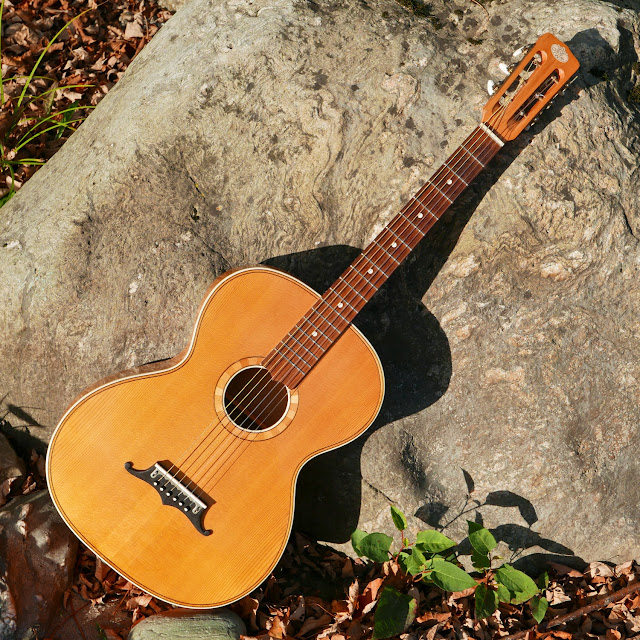1950s Otwin Parlor Classical Guitar
Update 2017: The owner of this guitar brought it back in for consignment and so I've included a soundclip and updated all of the photos. I also did a bit more work than discussed in the below writing -- a fresh fret level/dress job and fresh setup. It now plays with on-the-dot "classical" action at 3/32" at the 12th fret overall and with a straight neck.
Otwin appears to have been a brand related or owned by Musima, a big East German instrument company, though some of the guitars (it seems the high-end jazz archtops, anyway) were made by a small-shop luthier. This guitar was probably made around the late 50s and, when it was made, it was very much a throwback instrument as its closest "family resemblance" would be 1890s-1930s German parlors with their thinner-depth bodies and hourglass shape. The woods -- spruce over maple -- are also very "old German" as far as guitars go. This type of guitar is almost always intended to be strung for gut/nylon (which it came with from Germany to the owner), and the neck looks like it might complain, anyhow, if it were strung with steel.
There are interesting design elements with the instrument, too. The bracing is ladder-style and very spare, but below the bridge there are two odd, thin, half-circular braces that presumably stiffen the lower bout. You can visualize them as a sunrise over the endblock in terms of how they sit in the guitar. The other interesting bit is an original "adjustable saddle" piece I'll talk about in a bit.
This is roughly "0 to 00" in size, with a 13 7/8" lower bout width and a very Germanic, figure-8 body shape that gives it more airspace than your average "0."
The guitar is in really good shape and I did the desired work while the customer waited. It got a new bone saddle (for which the bridge needed to be modified to accept) and a light setup. Since the original blog post, I've also given it a proper fret level/dress job and it's ready to go.
This has a zero-fret and a 1 11/16" nut width which makes it a very comfortable chorder/folk guitar compared to your average classical. This is typical with Germanic-style folk-nylon/gut instruments that predate this.
The fretboard has a flat profile, frets with good height left, and I also added side dots.
You can see in these pics that the top is made from some nice, solid, tight-grain spruce.
I love the "arts and crafts" rosette.
The bridge is stained maple but quite pretty. The metal mechanism is actually the original saddle and the two set-screws let it slide forwards and backwards to set intonation, presumably. The issue was, however, that the owner wanted to give the guitar some more "guts" tone-wise, so I made a new bone saddle for it instead.
The proper compensated point was the leading edge of the bridge, so I got my Dremel out, cut a new slot, cleaned it up with files, and made the saddle to fit. We then put the adjustable saddle back in behind the new saddle to keep the decorative touch with the guitar. The new saddle, of course, is glued-in with a few dots of superglue to keep it from possibly tilting -- though the string tension actually kept it locked in its slot, anyway.
It looks handsome.
Did I mention that the guitar has zero cracks?
It looks handsome.
Did I mention that the guitar has zero cracks?
The flamed maple is easy on the eyes, no? The back and sides are ply, however, so all that gorgeous maple is simply veneer.
Your eyes are not deceiving you -- the back and the neck have a pinkish tint to their finish but the sides are left, essentially, natural.
The tuners are still going strong and look cool as heck.






















Comments
Otwin was founded in 1866 by one Franz Otto Windisch (hence Ot-Win) in Schilbach, but moved by his brother Paul Windisch to Schöneck in 1903. The company folded in 1972, after producting some nice archtop guitars and mandolins in the 1950s and 1960s. Musima, which produced a bit more bland instruments, was founded in 1952 and folded in 1992 and again in 1998.